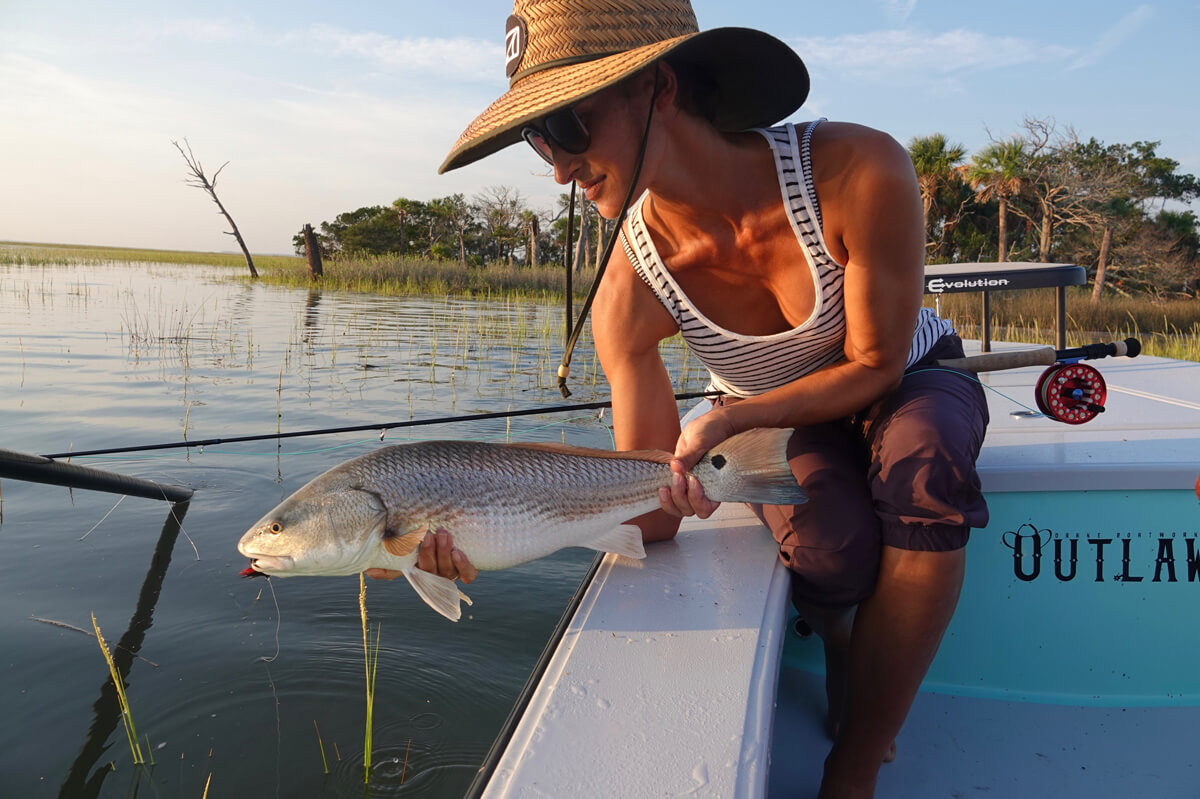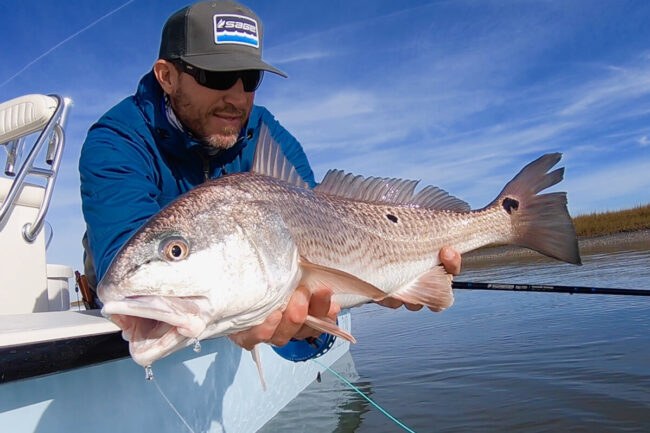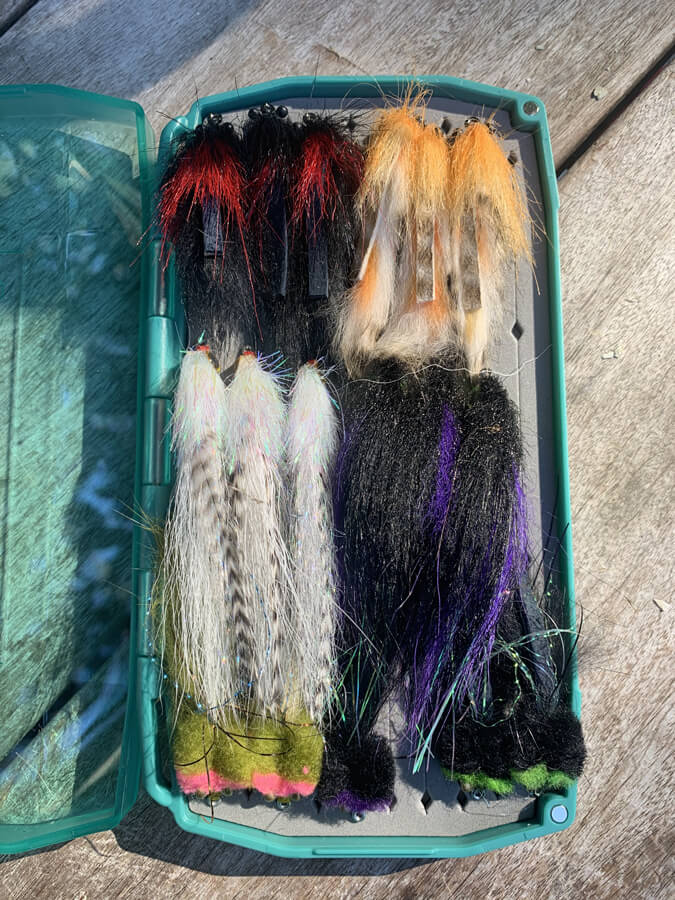The Lowcountry offers numerous fly fishing opportunities for a variety of species throughout the year. As you may know, redfish are the major draw, followed by cobia, tripletail, jack crevalle, and even some spotted trout and a few tarpon.
I’ve been guiding here in Hilton Head for well over 25 years and am very blessed to live in this beautiful place we call the Lowcountry. The best part about being a guide here is doing what I love while sharing this amazing fishery with visitors.
A frequent question I get is, “When’s the best time of the year to fly fish in Hilton Head?” My answer always is, “Every month has magical moments as long as the weather and tides come together.” Below is a synopsis of the seasons and species this part of the country has to offer, along with some commentary on equipment and terminal tackle.
Touching on gear, fish species, and time of year
by Captain Brain Vaughn
Winter (Redfish)
If you happen to visit during the winter months, considered the off-season for tourism in Hilton Head, you’re in for a treat. Some excellent opportunities exist to catch schooling redfish that can range anywhere from 1 to 12-plus pounds. Air temperatures average around 60 degrees but can dip well below that mark when a cold front pushes across the country. The colder weather causes the redfish to school up—and they do. Schools of hundreds of fish are usually found on the lower tides on mud flats, in front of creek mouths and oyster rakes. Sight fishing these schooling redfish is best on sunny days with light wind using a 7- or 8-weight rod with a weight-forward floating line or a floating line with an intermediate clear tip for deeper flats or for presenting to fish in crystal-clear water. Tapered leaders of 9 to 10 feet with 16- to 20-pound tippet are best, especially when fishing near oyster beds. As far as flies are concerned, many patterns work, but when I’m fishing clear water I prefer light-colored or flashy flies, as the client and I can easily track them while leading a fish. When the water is dark-colored or muddy and you’re casting to waking fish or mud puffs, larger patterns work best. When dressing, layer accordingly. A light waterproof shell jacket, a fleece, and a base layer should be all you need. Early mornings can be pretty chilly to start, but be ready to shed some layers as the sun warms throughout the day. You’re still in the South.
Spring (Redfish, Cobia, Tripletail)
During the spring months as the air and water temperatures rise into the 70s, baitfish schools, shrimp, and crabs start moving back inshore, getting redfish fired up bigtime. Baitfish patterns and topwater flies can be very effective on the flats and over oyster rake mounds on the middle of outgoing and incoming tides.
The species that comes to mind first when asked about my favorite fish on fly in the Lowcountry is the cobia. Cobia could possibly be the biggest of all the fish that migrate into our sounds and nearshore waters, but they also have the smallest window of opportunity, with only a month to six weeks of prime action per season. Late April through mid-June is prime time to sight fish cobia on the surface. The perfect setup is a 10- or 11-weight rod matched with a floating line and a 9-foot leader ending with a short piece of 40- to 50-pound bite tippet tied to a baitfish or eel pattern. Cobia can range anywhere from 10 to well over 50-plus pounds and are usually are spotted pushing a small V wake on the surface, especially on warm days with glass-calm conditions.
May is the month that cobia spawn in the sounds and rivers that surround Hilton Head and Beaufort. During the entire month of May, cobia are strictly catch-and-release. This was implemented by the South Carolina Department of Natural Resources (dnr.sc.gov/) two years ago to help their stocks return to normal. I’ve already seen a significant increase in their numbers over the last two years, and I expect this trend to continue throughout 2020 and beyond.
Tripletail are also a treat to encounter during the spring, but they can be very difficult to spot. They’re masters of camouflage and like to hang underneath floating debris such as driftwood and marsh grass. A 8- or 9-weight rod rigged with a small crab, shrimp, or baitfish pattern will work like a charm if you find one laid up on the surface or sitting below a piece of wood or grass. Tripletail range in size from a 1 to 15-plus pounds. My best is 16.8 pounds, taken on a red-and-white Lefty’s Deceiver, which set the IGFA 20-pound tippet record in 2010. The previous record stood for over 20 years.
Summer
(Redfish, Jack Crevalle, Spanish Mackerel, Bluefish, Ladyfish, Tripletail, Tarpon)
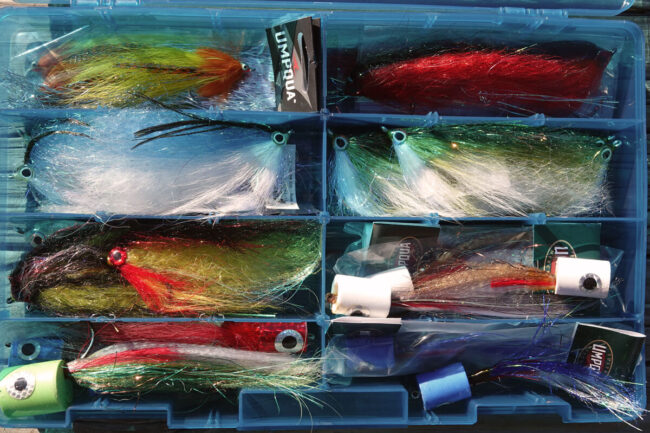 Summer is a melting pot of species to target on fly, but it’s hard to beat the summer flood-tide redfish fishery we have here in the Lowcountry. I’ve caught my share of redfish on fly over the years, but to this day my heart starts pounding when I see those fish, head-down in a foot or less of water, sucking up fiddler crabs, their spotted tails waving in the air like a flag. A 7- or 8-weight outfit matched with a floating line and a 9-foot tapered leader with 16- or 20-pound tippet is perfect for this fishery. Crab, shrimp, or baitfish patterns with weed guards are great for flood-tide reds.
Summer is a melting pot of species to target on fly, but it’s hard to beat the summer flood-tide redfish fishery we have here in the Lowcountry. I’ve caught my share of redfish on fly over the years, but to this day my heart starts pounding when I see those fish, head-down in a foot or less of water, sucking up fiddler crabs, their spotted tails waving in the air like a flag. A 7- or 8-weight outfit matched with a floating line and a 9-foot tapered leader with 16- or 20-pound tippet is perfect for this fishery. Crab, shrimp, or baitfish patterns with weed guards are great for flood-tide reds.
Our nearshore artificial reefs and sandbars off the beaches here in the Lowcountry offer some incredible action for Spanish mackerel, bluefish, ladyfish, and small jack crevalle. On the right day, you can catch all of these species and even have a shot at a tripletail. It’s very possible to start or finish the day with a redfish, completing the ultimate nearshore Lowcountry slam.
When fishing the nearshore wrecks and sandbars, I recommend an 8- or 9-weight floating line and a 9-foot leader with a bite tippet of tough, flexible coated wire, which is ideal for toothy critters like bluefish and Spanish mackerel. Clouser Minnows or other baitfish patterns with some flash work great on all of these fish, but be sure to have a good stock of flies in your box, as those toothy fish will shred the fly like a food processor.
A summer fishery I really enjoy is the jack crevalle. Pound for pound, crevalle are the strongest fish that swims in our waters. They start to arrive in late June and stay through September. These big jacks can be found inshore in pods of a few fish to hundreds of fish. They average 20 pounds here but can exceed 30 pounds. Use a 10- or 11-weight fast-action rod with a large-arbor reel spooled with a couple hundred yards of backing, as you will for sure be getting well into your backing if you hook one of these big fellows. Use a 9-foot leader with a short piece of bite tippet of 40 to 50 pounds. A baitfish pattern or popping bug will do the trick, as big jacks are very aggressive in close. They’re an extremely fast, powerful fish, and you can expect a 30-plus-minute battle and sometimes it can take hours. On September 18, 2018, after a three-hour battle, I set the IGFA 8-pound tippet record by catching a 35-pound jack that broke the previous record of 31 pounds, held since 1983.
Tarpon run as well during the summer months, but the majority of the time they’re found in deep channels, where they’re caught off of the bottom using bait. However, there are days when you’ll find them rolling on the surface. When this opportunity presents itself, use an 11- or 12-weight outfit to present a large baitfish pattern. This sometimes entice them to eat.
Baby tarpon from 1 to 10 pounds are abundant in certain saltwater ponds and lagoon systems that get a fresh flow of salt water from flood tides. These baby tarpon are a blast to catch using a 7- or 8-weight rod. I prefer small white baitfish patterns and especially Clouser Minnows.
Fall (Redfish, Trout, and Offshore Redfish)
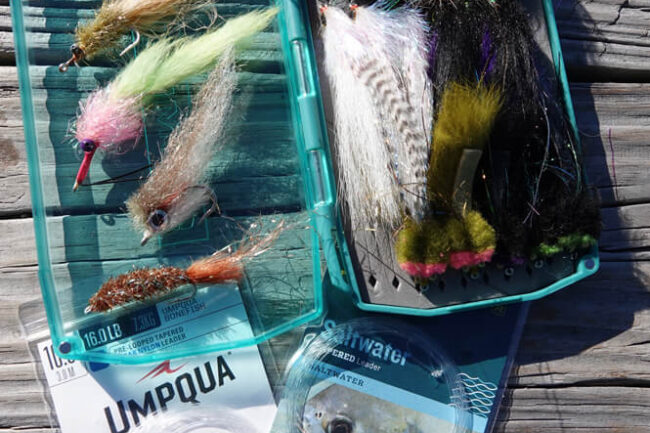 Fall is a great time of the year for redfish and sea trout inshore in the creeks and on the flats. Redfish can still be found tailing in the spartina grass flats until the water temperatures dip into the 60s, usually mid- to late November. Then the focus shifts more toward fishing at the time of low tide, as the redfish begin schooling up as they do during the winter months. You can also target speckled sea trout, as they’re very abundant in creeks and can be caught using a 7- or 8-weight rod using small white or chartreuse baitfish patterns or Clousers.
Fall is a great time of the year for redfish and sea trout inshore in the creeks and on the flats. Redfish can still be found tailing in the spartina grass flats until the water temperatures dip into the 60s, usually mid- to late November. Then the focus shifts more toward fishing at the time of low tide, as the redfish begin schooling up as they do during the winter months. You can also target speckled sea trout, as they’re very abundant in creeks and can be caught using a 7- or 8-weight rod using small white or chartreuse baitfish patterns or Clousers.
One of my favorite fall fisheries is the big bull redfish—25 to 30 pounds—found offshore in deep water. We use 10- or 11-weight rods rigged with fast-sinking lines and large baitfish patterns. These big reds can be found on artificial reefs or on ledges that hold baitfish. Dolphins and diving birds are usually a good sign you’re in the zone for a shot at one of these big fish. Of all the fisheries we have here in the low country, this one’s the most fickle and spotty. These fish are constantly moving, following the migrating schools of baitfish, and they can be there one day and gone the next. Finding a day with calm seas and light winds can be chancy in the fall and winter, so you have to be rigged and ready to go. Hope that the birds are doing their job to help you find the fish when do get the chance—because when it’s on, it’s on.
Bio: Captain Brian Vaughn is a Hilton Head native and has been guiding the area for more than 25 years. He’s an amateur photographer and has a wealth of information to share about fishing the Lowcountry. While you can sometimes find Brian at Southern Drawl Outfitters (southerndrawloutfitters.com), it’s probably best to email him at captainbrianvaughn@gmail.com or visit his website (offthehookcharters.com/ ).
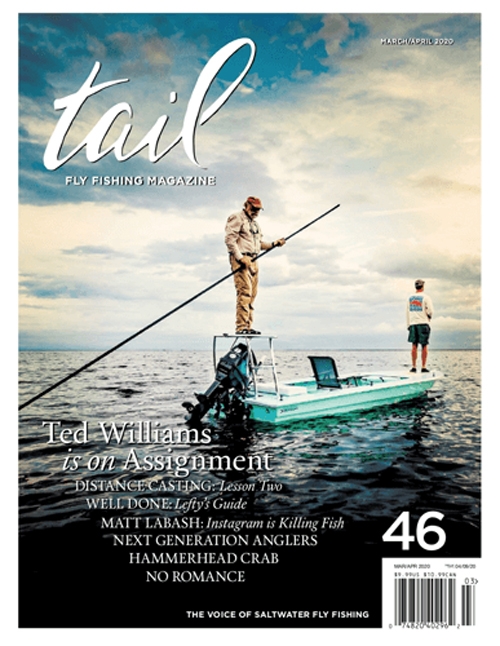 SUBSCRIBE TO TAIL FLY FISHING MAGAZINE
SUBSCRIBE TO TAIL FLY FISHING MAGAZINE
More saltwater fly fishing blog posts:

